Acrylic paint is the favored medium for painting miniatures and models. But, did you know you can paint your models with oil paints, too? Oil wash filters and weathering with oil paints create amazing effects that can add realism to your miniatures. If you’re painting wargaming models, e.g., Warhammer 40k or Age of Sigmar, then oil paints may be a great way for you to explore new techniques and looks for your miniature collection.
In this article written by Frank Shic, you’ll learn how you can use oil paints for more than simple washes. In this how-to guide, you’ll see how you can prepare and incorporate oil paints into your miniature painting workflow.
Here are a few high-quality oil paints we recommend for miniature painting:
| Recommended Oil Paints for Miniatures | |
|---|---|
| Winsor & Newton | Check Price at BLICK ART Check Price on AMAZON |
| Grumbacher | Check Price at BLICK ART Check Price on AMAZON |
| Gamblin | Check Price at BLICK ART Check Price on AMAZON |
| Recommended Budget Oil Paint Sets | Check Price at BLICK ART Check Price on AMAZON |

Read on for the oil paint tutorial for painting miniatures!
Oil paints for painting miniatures?
I have used acrylic paints like Reaper Master Series or Games Workshop Citadel paints for years in painting miniatures, but was always intrigued when I heard oil mentioned by various miniature painting forum members.
Oil paints are are well-known for their extended working time (e.g., they dry or cure very slow!) as well as superior blending qualities compared to acrylic paints. This especially appealed to me since I had adopted wet blending as my favored painting technique due to both its speed and simplicity.
But I found wet-blending definitely wasn’t perfect because I had to move quickly before the acrylic paint started drying.
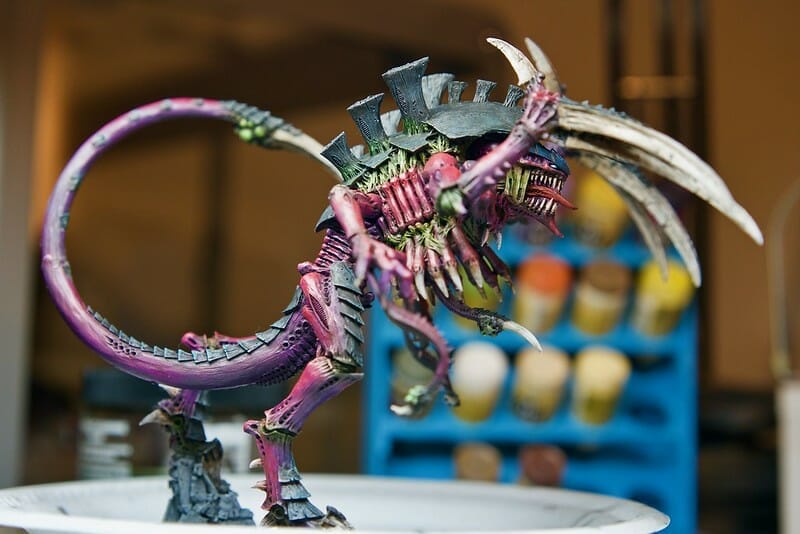
I tried Ammo Mig Oil brushes, but was not content with the color range which was more suitable for military models.
So, I abandoned oil paints for a while, but after watching a recent James Wappel Patreon video entitled “Creating your own oil brushes”, I was inspired to replicate the process with uncle’s 30+ year old Artist’s Oil Color paints that were sitting in a garage drawer my in order to give oil paints another try in my never ending quest for the Holy Grail of miniature paints!
RELATED: BEST INKS AND HOW TO USE THEM FOR PAINTING MINIATURES
If you haven’t seen James Wappel’s work, he uses a process of diluting and transferring oil paints into the more familiar plastic dropper bottles that companies like Reaper and Army Painter use and explained how mixing the oil paint with mineral spirits dramatically speeds up the drying time.
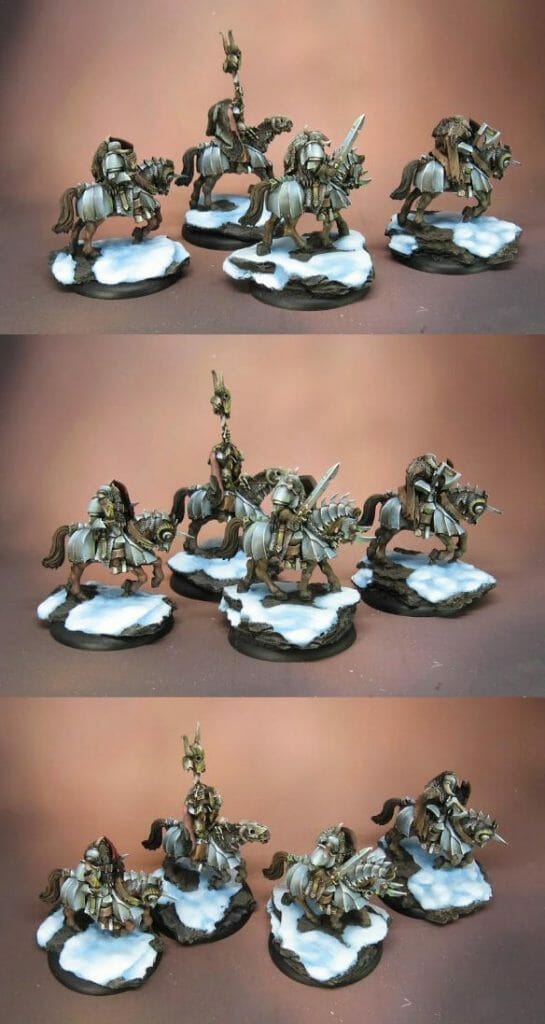
So, do you want to give this miniature oil painting method a shot?
How to transfer oil paints into plastic dropper bottles
How do you use oil paints for painting miniatures? Well, let’s make it easier first.
I recommend transferring your oil paints into dropper bottles for easier dispensing when painting. Transferring oil paints into dropper bottles makes painting miniatures with oils much easier!
Here are the quick 8 steps for oil paint transfer into dropper bottles:
- Wear disposable gloves
- Insert a 8mm agitator hematite bead into your 20ml dropper bottle
- Fill 1/3 of the dropper bottle with clear, odorless mineral spirits using a pipette or syringe
- Place oil paint into the dropper bottle
- Cover the top of the dropper bottle with your gloved thumb and shake HARD (e.g., you can also use a powered model paint shaker)
- If the paint has mixed with the mineral spirits, repeat from step #4 until the dropper bottle is full
- Check to make sure the oil paint has thinned by listening for the agitator bead; it should be audible
- Label your dropper bottle
Wear Gloves
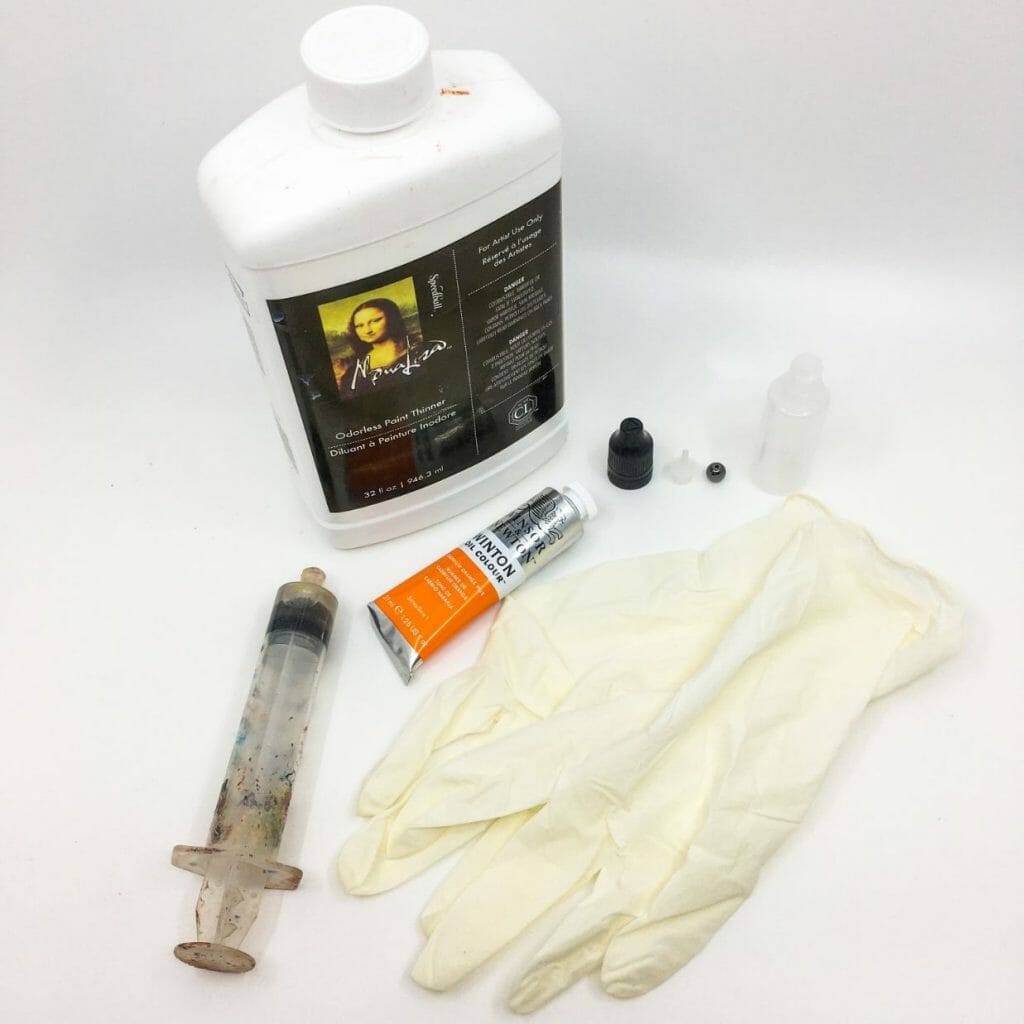
I found the easiest way to accomplish the task of transferring and preparing oil paint for miniature and model painting is to start with donning a pair of nitrile or latex gloves. This will prevent staining of your fingers.
Add agitator bead and mineral spirit into dropper bottle
Insert a 8mm hematite round bead or cut up metal pewter sprue to serve as a paint agitator in a 20 ml dropper bottle and fill it approximately 1/3 of the way with artist-grade (NOT hardware-grade) odorless mineral spirits using a plastic syringe or pipette.
Dispense oil paint into bottle
Position the mouth of your oil paint tube inside the mouth of the dropper bottle and squeeze the tube until the paint begins to clog up the neck of the bottle. It will greatly help to compress the bottle slightly before hand and release the pressure gradually as the paint enters the bottle to take advantage of the suction.

Shake to mix oil/mineral spirit
Cover the mouth with your gloved thumb and shake HARD as the paint is extremely viscous initially. You can use a powered small model paint mixer or shaker to help you in this step.
If you listen carefully, you should eventually hear the thinned paint sloshing around inside like a liquid.
At this point, you can squeeze some more paint into the bottle and repeat the shaking process again until you hear the hematite bead moving again and a duller sound of the thickened paint mixture.
Keep adding oil paint, if needed
If you cannot hear the bead, your mixture is likely too thick and will require additional thinning.
Frequently, the paint will clog up the neck of the bottle but can be coaxed back into the main body by gently tapping the bottom of the bottle on a hard surface although I advise covering the mouth with either your finger or a napkin to prevent the paint from splattering.
Pro tip: Wipe your fingers off with a paper towel or napkin if they’ve been stained by the paint to avoid getting the paint on the bottle or your clothes.

Your goal is to create a oil paint/mineral spirit mixture that has a gel-like consistency. Essentially, you want your oil paint to have the same viscosity as normal model acrylic paint.

Label the bottle
Complete the transfer of oil paint by printing out some Avery labels (e.g., sticker labels) to help you identify the colors, especially on the darker oil paints like Prussian blue, Van Dyke Brown, Payne’s Gray and Ivory or Lamp Black.
You can download the labels for printing in the shop.
Consider dipping the tip of the dropper bottle cap in the paint to make color identification easier.
When viewed from above, you’ll be able to see the color inside the bottle easier this way. Be aware that it may take several days to fully dry so watch out for staining especially on your nice shirt sleeves!

For a more thorough tutorial on how to paint miniatures and models entirely with oil paints using the preparation you have made, check out this video:
Is oil paint easier than acrylic?
Oil painting is fairly intuitive after you get accustomed to thinning down the paint with mineral spirits. The best oil paints are have very fine ground pigments and allows you to make extremely smooth blends that easily rival that of an airbrush without all the hassles of cleaning and maintenance.
With oil paints, you can take short cuts that you have to do with many advanced acrylic painting techniques.
For example, you can skip the applications of multiple coats of acrylic paint you need for proper glazing or layering, or having to move quickly when you’re wet blending with acrylic paints.
There are some unique challenges with oil paints.
You will have to understand how the concept of oil painting “thick over thin”. The thick over thin principle is that layers of oil paint with similar consistency will not adhere to one another. However, the solution is to either use a thicker consistency of oil paint over a thinned layer, or vice versa.
Clean up with oil paints is a bit trickier (but not hard at all), as you can’t use your water alone (e.g., oil and water don’t mix).
To clean your brushes, palettes, and other art materials, you’ll need to use soap and/or mineral spirits. I don’t recommend the use of turpentine; it is unnecessary and has a strong harmful vapor.
In retrospect, I wish I had started using oil paints much earlier although I appreciate them so much more after having used acrylic paints for so long!
Why do so few miniature painters use oil paints?
More miniature painters do not use oil paints for the following reasons:
- Perceived difficulty in adopting a new paint medium that requires using mineral spirits for dilution and cleaning instead of water, which is much more accessible.
- Oil paints can take a week or even a month to dry if applied in the traditional manner without diluting it with mineral spirits.
- Most of the popular miniature painting channels on Youtube as epitomized by Games Workshop‘s former lead painting instructor, Duncan Rhodes, use acrylic paints. There is one notable exception namely James Wappel who inspired me through his Patreon videos to give oil paints a try. If you are curious to see what results you can achieve with oil paints, I highly encourage you to watch this master painter at work.
- The cost of a tube of 37 ml oil paint can be a potential financial obstacle since they vary widely depending on which brand and what colors you choose – starting at roughly $4 a tube in a $39.99 Winton 10 paint starter set to $61.79 for a 37 ml tube of Windsor & Newton Artist Oil Cobalt Purple if purchased at Michael’s hobby store. The upside is that you can make several dropper bottles with one tube of oil paint.
If you think about it, however, none of these reasons are a major hurdle if you’re patient, prone to experimentation, and willing to take some risks with your hobby.
MORE: 10 BEST OIL PAINTS FOR PAINTING MINIATURES AND MODELS
How do you paint miniatures with oil paints?
Painting miniatures with oil paints is similar to using acrylics although you will need to use mineral spirits to clean your brush and to dilute the paint.
Instead of applying the paint in layers like you do with acrylic paints you can apply two colors next to each other and then blend them together by lightly stroking the area where they meet with the brush – this technique would be referred to as “wet blending” when using acrylic paint.

With the extended working time of oil paints, you can apply your shadow or highlight color followed by the other color and still have more than enough time to blend them at a leisurely pace as opposed to wet blending with acrylic paints which requires more of a rush to blend before the paint starts to dry.

Another bonus to using oil paints is that you can easily clean up any messy areas on your model afterwards with mineral spirits directly applied to the surface.
If you’re afraid to try it on a new model, find a scrappy bit or something from your bitz box. Power swords or armor pieces are great places to practice using oil paints and oil blending techniques.
What about oil washes?
Although there are several vendors of ready-to-use oil washes, like AMMO and AK Interactive, making your own oil wash is extremely easy especially if you already have the oil paint and the mineral spirits.
Compared with GW Citadel Washes, oil washes are easier to use when you understand how easy it is to move it around.

For vehicles or large models, I prefer using oil washes versus gw washes because they are most cost effective, faster to use, and provide similar or better results.
RELATED: USING OIL WASHES ON 3D PRINTED MINIATURES AND MODELS



The great advantage of using oil washes is that you can wipe away the excess with a cleaned brush so that the original underlying paint does not get overly darkened as it would if you had applied an acrylic wash like Agrax.

In fact, by using different oil paint colors you can use oil washes as color “filters” that subtly change the overall feel of your model. This adds interest without detracting from the overall look of your models.
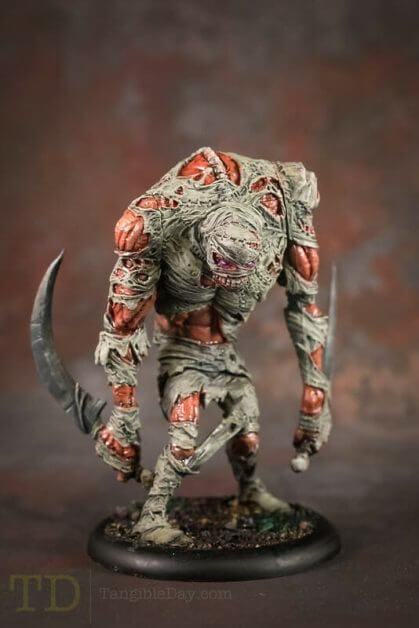
Remember to varnish your oil painted miniatures
If you want to use your models for gaming or tabletop play, remember that you’ll want to varnish your oil painted miniatures to protect them. I suggest you use a durable enamel based lacquer, like Testors Dullcote.
MORE: RECOMMENDED VARNISHES FOR MINIATURES AND BEST PRACTICE FOR USE
Oil paint cures slowly, but you can speed up this process by applying some heat with a hair dryer. Just make sure you don’t heat up oil too quickly, or it will cure unevenly and you’ll risk cracking thicker aspects of it.
Conclusion
Painting miniatures is a hobby with no boundaries. Although most painters use acrylic model paint, the rare few use oil paints exclusively.
If you’ve been painting miniatures for a while, then you already know how to use oil washes and filters. But, it continues to be true that oil paints are only mostly used for weathering wargaming miniatures or scale models.
Painting entire figures with oils alone is still something the broader miniature painting community has yet to embrace.
However, there are many miniature oil painting tutorials out there, including those that show you how to use oil washes. Of course, why follow others’ lead when you can experiment for yourself with oil paints.
I hope this article inspires you to try using oil paints, and has been helpful for how to use oils paints for painting your miniatures and models. The great thing about oil paints is that it takes a long time to dry, so if you’re not happy, you can always move colors around to take them off altogether with a bit of mineral spirits.

Frank is a Dad, miniature painter, tabletop gamer, and medical physician. He lives happily in California with his family.



Tangible Day on YouTube (Miniatures and More!)


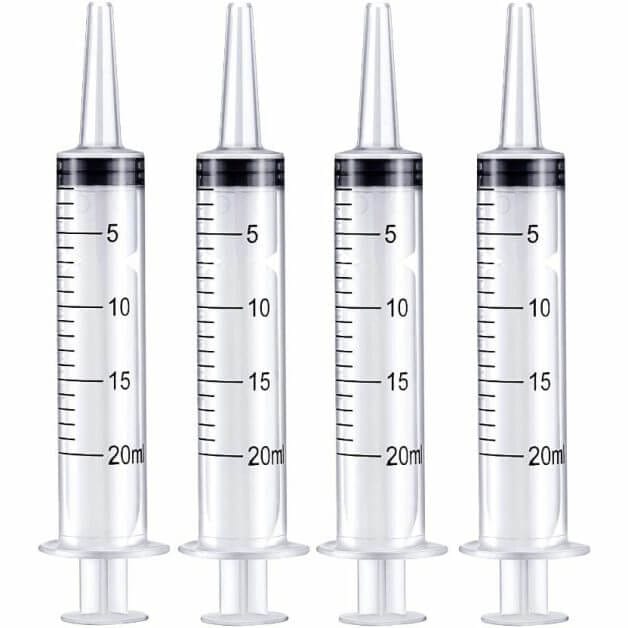
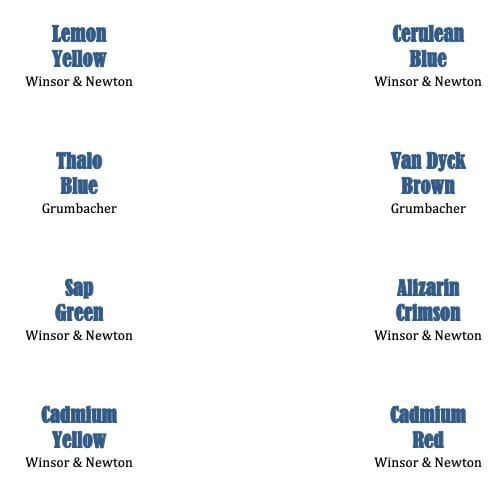
I’m struggling with all these guides only mentioning white spirits as it has different names around the world but are based on mineral oils. The thing is for me that I followed ninjons video and didn’t varnish my models beforehand and rubbed off the whole paint job after 10 minutes. I tried with a varnish again yesterday, although not that bad, some paint came off too. Since white spirits are solvents it’s what they do, so I’m uncertain what to try next, I guess you just got lucky with yours, but there seems to be a lot of differences between them so maybe a fair warning or some research on what works would be nice.
Are you trying to layer with oil paints in the same fashion as acrylics? One tip I should emphasize is to not to clean your brush with mineral spirits between oil colors. you also need to wait a bit (between 5-30 mins in some cases) between oil paint applications – it varies because different colors dry at different rates. Btw, white spirit is the same as mineral spirits. Can you be more specific as to what you’re trying to do? Maybe I can provide more detailed advice.
Hey Tangible day, thanks for the guide. I just wanna add some information here on the naming of white spirits outside of English speaking countries. In Spain you can still find it as white spirit on amazon.es, but I think the most common name would be Aguarrás. That’s the name you wanna use if you are in Latin America. I think I’ve heard they call it very similar to Aguarras In Italy (not the exact same word), but I am not sure on this one.
Do a search on the site. There are some step by step tutorials I did that walk you thru my process what paints I use and how I apply them.
Maybe that could jumpstart or troubleshoot some things for you?
Thanks for the article! It is one of the most thorough guides to oils I have found.
I’ve been trying to get the hang of painting with oils for about a month now but feel like I’m struggling with something fundamental. I followed your steps to “pre-mix” the paints so they have a gel like consistency in line with the acrylics I’m used to, but I find that no matter what kind of paint I am trying to apply, it goes on very thin and spotty and seems to have almost no coverage. This is the case regardless of whether I’m painting over a black undercoat or a white undercoat. If I apply the paint to a mini it leaves wide streaks where whatever layer is underneath is completely visible. I’ve looked up lots of oil painting videos and my paints seem to behave entirely different. The individuals making videos seem to be able to apply a base layer and get a solid, opaque layer to work off of with no effort.
I’ve also tried applying a layer and allowing it to sit for about 30 minutes before continuing, but it comes off almost immediately when my brush touches it, even after that.
I have had some success doing mono color blends with red, brown, and blue, but have had no luck using yellows and greens. These successful attempts also only ever work when I’m applying them over a solid base of the same color (typically done with acrylics or an airbrush).
Thanks again for your article and I appreciate any advice you might have!
Hi! Yes, painting with oils is tricky. I have a bunch of step by step examples of painting miniatures from start to finish with oil paints. If you do a search for “oil painting” on the site, you’ll find them. Here’s one for starters, which may help you get past those early stages with oil painting minis. https://tangibleday.com/oil-painting-tutorial-for-an-infinity-miniature-step-by-step/
Thanks so much for the reply and the link! After giving it a read I understand I was not being smart with my undertones. After playing with the base acrylic/primer layers I was able to get some much better results.
I really appreciate it!
Awesome! Send me photos – I’d love to feature your work in a future article (if you’re up for it!). Or, if you’d like to write up how you approached your painting process… I love hearing and sharing others’ perspectives here.
Your guide really helped with my project! I had to take a big of a hobby hiatus due to real life, but managed to get back to the table and finish up the mini. I painted a Warhammer AoS Glutos model for a friend. If you would like any pictures, or progress pictures, I would be happy to share!
Thanks again for all the help!
Lovely! I appreciate the comment and I’m really glad you’re back in the hobby! Sure, send me an email…there’s a contact link at the bottom of the page 🙂
Thanks very much for the guide! I gave it a go and all was well, but a month later it looks like the spirits have eaten away some of the plastic, making it feel super thin where the spirits has separated out from the paint while being stored. Is this something you’ve experienced, or should I be looking at a different thinner (I didn’t use mona Lisa), or bottle?
Hmm I didn’t notice the the bottles I used degrading. But it’s possible some plastics get soft when exposed to some harsher solvents. I only used Mona Lisa spirits. Maybe yes go with a different thinner?
Thanks for the reply! I’ll get hold of a different thinner 🙂
I have been watching videos and reading articles about miniature painting with oils, and there’s one thing I haven’t found an answer still. All videos/articles talk about oils that need mineral spirits/turpentine as a medium, but there are also water soluble artistic oils (for example from W&N, the same brand you are using for traditional oils). Have you used those? Do you have any opinion on them? Thanks!
Yes I have a lot of the water mixable paints from W&N. They are great but they are only water mixable for a few minutes until the water in them evaporates.
They are still best thinned with mineral spirits. If anything they are useful because you can clean your brushes with water more easily.
I say give them a try. Water mixable paints work well and have good color and behave like regular oil paint 🙂
Thank you so much! I really appreciate that you took time to answer 🙂
I’m happy to learn, too, and try out new things 🙂 eyes peeled !
Hi there, thank you for your explanations. It looks very attractive since I already paint with oils but without adding mineral spirits. BUT with your way the oil becomes more liquid and does it make the BLENDING more difficult ? Thank you very much in advance. Cheers, Jim
Thanks for the comment! The mineral spirits help the oil stay fluid when you apply it on a model. But, you need to allow the spirits to evaporate a bit on the mini before you add more color for blending. Actually adding spirits does help the oil dry a bit quicker because each layer you’re adding is thinner than if you apply straight oil from the tube. The spirits also help the oil color retain detail on the model (you’re not using paint that is too thick). 🙂
Thank you very much. Actually, I’ve never tried to blend with super thinned layers. I just am curious to see if when I’ll zigzag the 2 different areas together, the oil will move easily. Btw I will no add extra painting before blending as you wrote, I will just block in areas and then blend them together. Does it make sense ? Best regards, Jim
Yup. I tend to wait until the oil paint I applied doesn’t look as shiny before adding more on top. It can be slow… but the patience is worth it for how nicely you can blend colors together. Takes a bit of practice. 😉
Hi there, sorry I don’t follow you. Why are you adding more colour on top instead of blending ? Cheers, jim
Maybe this tutorial will help? https://tangibleday.com/oil-painting-tutorial-for-an-infinity-miniature-step-by-step/
Pingback: Miniature oil painting earrings - Jewelry Directory
Hi there! Thank you for the guide! I’m having some concerns with how long the minis take to dry to a point where they can be varnished. I have some that weee painted two weeks ago and the paint can still be wiped away by gently wiping with a sponge.
How long do you find you need to wait before a mini is completely cured?
Thanks again!
Oil paints can take a long time to “cure” as you know. A tip for speeding up the process (before you paint) is to thin out the oil with solvent first (mineral spirits).
You can also try and leech out the oil from the paint by loading some of the paint onto an absorbent surface like cardboard or a wooden palette first.
Once on the model, two things make oil paint “dry” faster: oxygen exposure and sunlight. In this case, thinner layers cure faster. Apply one layer or two and let it dry before applying wet oil on top. This increases dry time speed.
Some colors also cure faster than others. Earth tones (browns) tend to dry fastest. Green and blues are a tad slower etc.
There are also drying mediums called alkyloids gels. You mix them into the paint and it dries faster. Of course they can also make it glossy and harder to use for certain things.
Keep at it! Let me know how it goes. Oils are certainly a trial in patience but the results can be spectacular!